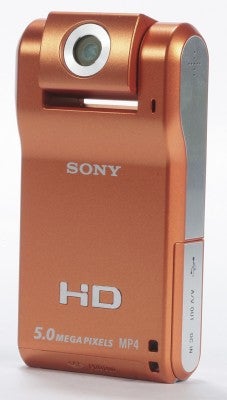Sony's MHS-PM1 HD camera offers 1080p (1440 x 1080) HD video recording at 30 frames per second in MP4 format...
Sony MHS-PM1 HD camera
The video camera has come a long way from the giant shoulder-crushing boxes of the late 1980s, with even our mobile phones now capable of recording passable video footage. A few years ago, a device called the Flip offered a dedicated video camera around the same size as a phone that took VGA quality video. This was quickly followed by a more powerful HD version, setting the trend for the latest ultra-compact video cameras, with Samsung and Sony both recently launching new models. Sony’s is the Sony MHS-PM1 HD camera, tested here.
Sony’s version certainly makes the concept seem all the more appealing by offering 1080p (1440 x 1080) HD video recording at 30 frames per second in MP4 format, and 5MP still images from its CMOS sensor – more than enough for a standard snap.
Its unique feature, however, is the way the lens is mounted: unlike the fixed lenses of the Samsung and the Flip versions, the PM1’s lens rotates up to 270 degrees to allow you to angle the lens to a comfortable position for handholding, or even turn the lens right around to face you so you can record yourself.
The Sony PM1 comes in just one colour: metallic orange. Though this may not be a natural first choice for many, it is distinctive and actually suits the product very well. The screen is a small 1.8in LCD and, due to the widescreen nature of HD, shows quite a small image, but it’s clear enough and easy to use. The buttons are kept to a minimum with the main controls being a simple Movie and two-level press Photo button, with a central digital zoom rocker.
For navigation there’s a mini joypad, plus buttons for reviewing and sharing your images. On the side there are further buttons for power, menu and resolution/delete. The device can be turned on and off by rotating the lens, which makes it fast to power up and start shooting.
For still photos, however, the PM1 can be quite frustrating. The half-press on the photo button activates the focusing, which is a little slow, and even after this there is a slight lag between the full press and the shot being taken. And, if you try to press the button straight down you can be waiting nearly three seconds before it takes the shot.
Storage is in the form of a MemoryStick Duo card that has to be bought separately, adding an extra £15-20 to the price. A USB lead is supplied to share your images, or the card can be removed.
The quality of the video from the PM1 is pretty impressive, though lacks the luxuries of stabilisation or face detection, and it can struggle in low-light situations.
The images are fine as snaps, but the lack of flash is limiting and close inspection reveals some texture which looks like a result of over-compression.
Verdict
Overall this device is about video and if you are after this type of device, then this is definitely one to consider.





